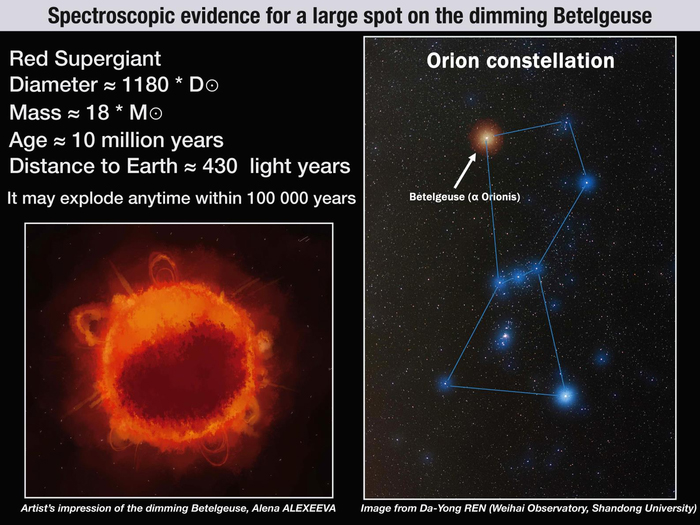Mysterious dimming of bright star Betelgeuse possibly explained

The mysterious strange dimming seen last year in the huge star Betelgeuse may be from giant sunspots and temperature fluctuations.
A new study suggests a "large dark spot" led to Betelgeuse's surface temperature dropping, which in turn contributed to a temporary dimming in the red giant's luminosity or inherent brightness.
The stark fading generated headlines around the world in 2020 as speculation mounted about what was going on. The science is still unclear, but astronomers are blaming everything from gas cloud emissions, to dust, to stellar fluctuations before Betelgeuse eventually explodes as a supernova.
Related: Scientists still stuck on Betelgeuse a year after strange dimming episode
The new study, led by the Chinese Academy of Science, looked at molecules in the spectra — or light signature — of Betelgeuse to try to figure out what was going on. To do so, they used Weihai Observatory (based at Shandong University in Jinan) four times in 2020 across the dimming and rebrightening period: on Jan. 31, March 19, April 4 and April 6.
To estimate the star's temperature, astronomers examined molecules of titanium oxide and cyanide, which tend to form more readily in cooler star environments.
"The cooler a star is, the more these molecules can form and survive in its atmosphere — and the molecular lines are stronger in the stellar spectrum," lead author Sofya Alexeeva said in a statement released Aug. 5. "In a hotter atmosphere, these molecules dissociate easily and do not survive," Alexeeva added.
Sign up for the Live Science daily newsletter now
Get the world’s most fascinating discoveries delivered straight to your inbox.

When Betelgeuse was at its dimmest on Jan. 31, 2020, its effective temperature — meaning, the temperature calculated from its emitted radiation — was measured at 3,476 degrees Kelvin (about 5,800 degrees Fahrenheit or 3,200 degrees Celsius.)
But once the star was back to a normal luminosity, measurements indicated an almost 5% temperature rise to 3,646 Kelvin (roughly 6,100 F or 3,370 degrees C.)
Given that Betelgeuse could still be many hundreds of years from going supernova, the astronomers said in their research paper, which was published Aug. 5 in the journal Nature Communications, they concluded it is unlikely the entire surface cooled temporarily by that amount. Rather, it must have been a sunspot — or rather, a "star spot" — blocking some of Betelgeuse's radiation from escaping, they said.
Star spots, like the sunspots that appear on the sun, are believed to be common on red giant stars such as Betelgeuse. The blemishes arise as disturbances in a star's magnetic field flow to the photosphere, or the visible surface of the star. Sunspots tend to be large clusters of magnetic activity and can lead to flares or emissions of particles known as coronal mass ejections — the source of the solar wind in our solar system.
While this temperature study was focused on Betelgeuse's dimming, the team said future research in this field could better inform our study of all red giants — the primary source of heavy elements in the universe, due to the stars' tendency to explode and spew material.
Follow Elizabeth Howell on Twitter @howellspace. Follow us on Twitter @Spacedotcom and on Facebook.

Elizabeth Howell was staff reporter at Space.com between 2022 and 2024 and a regular contributor to Live Science and Space.com between 2012 and 2022. Elizabeth's reporting includes multiple exclusives with the White House, speaking several times with the International Space Station, witnessing five human spaceflight launches on two continents, flying parabolic, working inside a spacesuit, and participating in a simulated Mars mission. Her latest book, "Why Am I Taller?" (ECW Press, 2022) is co-written with astronaut Dave Williams.










